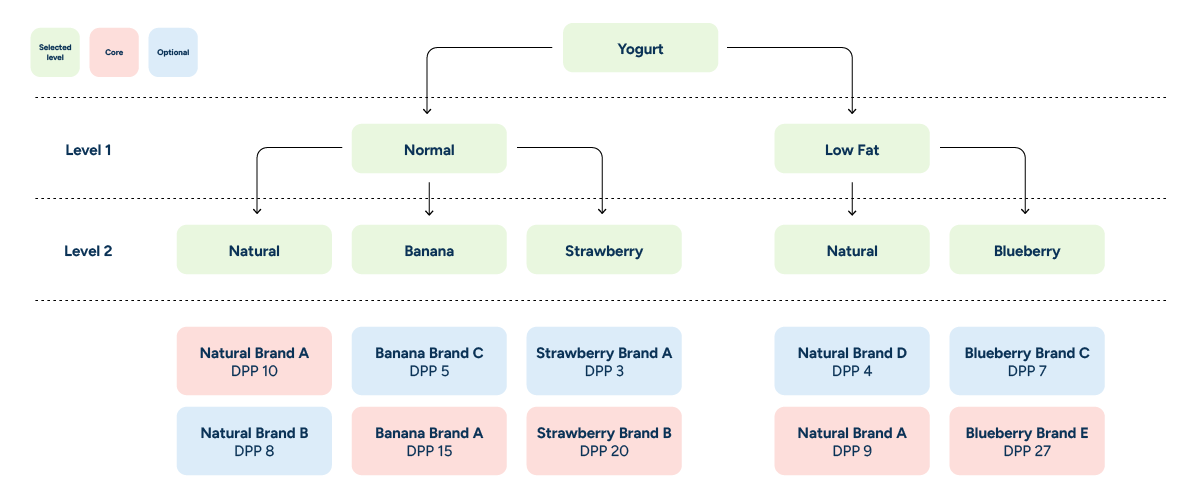The need for consumer decision trees (CDTs) in assortment rationalization
Jun 13, 2024 • 7 min
Category managers aren’t mind readers — though their jobs would certainly be easier if they were.
Any specific category might contain dozens of individual product offerings. Each product has unique features that factor into a customer’s final purchase decision — one made in silence, with no easily discernible reason for a particular choice. If category managers could see how these factors impact the decision-making process, they might be able to serve their customers better.
Visualizing the customer decision-making process is essential to the success of assortment rationalization. Consumer decision trees (CDTs) can help category managers make informed decisions about product assortments, ensuring selections align with consumer preferences, maximize sales potential, and optimize shelf space utilization.
Retailers looking to gain insight into customer decision-making and optimally manage their assortments should use consumer decision trees to their advantage — and they must use the right planning solution to do so.
What is a consumer decision tree (CDT)?
A consumer decision tree (sometimes category decision tree) is a visual roadmap of the steps and criteria a customer considers when purchasing a specific product. It unveils the hierarchy of product attributes that matter to a customer.
Such attributes include:
- Brand
- Size
- Flavor
- Price
- Quality
CDTs are indispensable assortment rationalization tools for retailers seeking to ensure that their product offerings cover all the relevant consumer need states within a category. They allow category managers to prioritize products that meet the highest consumer demand, eliminating those that don’t add significant value. This ensures the assortment is comprehensive and efficient, reducing redundancy and focusing on items that drive customer satisfaction and sales.
The visualizations also help identify gaps in the product range, revealing opportunities for new product development or adjustments in existing offerings. This insight enables proactive decision-making, ensuring that the assortment evolves with changing consumer preferences. Such agility can be a significant advantage in the ever-competitive retail landscape, helping companies stay ahead of trends and maintain customer loyalty.
Integrating CDTs with Direct Product Profitability (DPP) for assortment decisions
Consumer decision trees are especially powerful when used with the Direct Product Profitability (DPP) metric. DPP measures the actual forecast profit generated by a product, considering all direct revenues and costs. This metric provides a comprehensive view of a product’s profitability.
Taking advantage of these two components requires the right planning software. RELEX combines CDTs with DPP to determine the core and optional products within a category. CDTs reveal the key attributes driving consumer decisions, while DPP quantifies the profitability of each product. This combination allows category managers to make data-driven assortment decisions aligned with financial goals while satisfying consumer preferences and needs.
When multiple products cater to the same consumer demand state, the product with the highest forecasted DPP is designated the core product. Core products secure a permanent spot in the assortment due to their high profitability and strong alignment with consumer preferences, whereas the software might recommend removing products with lower forecasted DPP.
The types of consumer decision trees
Consumer decision trees can be structured in various ways depending on the complexity of the buying process and the diversity of products involved. The structure influences how retailers organize products, set up marketing strategies, and even lay out their physical or online stores.
Common CDT structures include:
- Flat structures allow consumers to make choices based on limited attributes considered simultaneously. They are often used for less complex products or when there are a few differentiating attributes, like pasta of varying shapes.
- Hierarchical structures involve multi-level decision-making, where each choice leads to a new set of attributes that further define the options. A grocer might have consumers decide between food types, then brands, and finally, other attributes — like organic over non-organic.
- Sequential structures follow a specific order where one decision directly leads to the next. These are used for products that require a step-by-step decision process like computers (first brand, then processor type, then RAM size, and more).
- Nested structures combine elements of hierarchical and sequential structures, where each branch of a tree can contain sub-branches that follow a sequence. These are common in highly diverse categories, like apparel, where you might choose a type of clothing, then a style, and then specific features like color or material.
- Non-compensatory structures remove a product from consideration if it fails to meet a critical criterion at any decision point. They are used for products where certain attributes are “deal-breakers,” like televisions over a certain pricing point.
RELEX uses flat-structured CDTs for assortment rationalization. A flat structure allows for a more straightforward analysis of product attributes without navigating a complex hierarchical tree structure, enabling direct examination of attribute combinations. This capability ensures assortments always contain at least one product representing each necessary attribute combination to cover a category’s relevant consumer need states.
A flat structure facilitates a more efficient and focused approach to assortment rationalization, focusing on maintaining a balanced, comprehensive assortment while optimizing for profitability. The simplest way to do this is using CDTs to identify core and optional products within each attribute combination. The best-performing items in forecasted DPP within each attribute combination can be designated core products, which should always be kept in the assortment. Non-core products can then be identified as optional and considered for removal.
Symmetrical vs. asymmetrical: Using consumer decision trees to ensure product diversity
There’s another major structural factor of consumer decision trees that impacts assortment rationalization: symmetry. CDTs can be symmetrical or asymmetrical, with each form crucial in maintaining product diversity and meeting various consumer demand states.
Symmetrical consumer decision trees
In a symmetrical CDT, each decision branch mirrors the others in structure and depth.
Consider the yogurt category, where fat content and flavor serve as the first and second levels of the CDT. Without specific CDTs, the product with the highest Direct Product Profitability (DPP) in the yogurt category — like the low-fat brand E yogurt in Figure 1 — might become the core product. However, setting fat content as the first CDT level and flavor as the second ensures all flavors will have a core product regardless of whether it is a normal or low-fat yogurt.

Using symmetrical CDTs in assortment rationalization helps maintain a balanced and comprehensive product mix. Category managers ensure that each decision branch is equally represented, preventing overemphasizing a single attribute or product type. This balanced approach ensures that all diverse consumer preferences are addressed while simplifying analysis and decision-making regarding the retention of core products.
Asymmetrical consumer decision trees
Asymmetrical CDTs forego the more rigid structural requirements of their symmetrical alternatives, which introduces flexibility to proceedings.
In a hypothetical example, fat content serves as the first level. Flavor and price are then considered at the second level, and the product with the highest DPP under the lowest level becomes the core product. Decision paths can vary greatly in an asymmetric structure, with one branch potentially going three levels deep while the other remains at one level. Asymmetric CDTs accommodate the nuances of consumer preferences to ensure all customer needs are met.

Fat content is the first decision level for the consumer. At the second level, health-conscious consumers choosing low-fat might prioritize flavor, while those less concerned about fat content might prioritize price for normal-fat yogurt. This asymmetrical structure allows for varying decision factors at different levels, ensuring that all customer needs are met.
Asymmetrical CDTs allow for greater flexibility and customization in assortment rationalization. They can adapt to complex consumer preferences, ensuring a more personalized product assortment. This approach helps identify niche markets and cater to diverse customer needs. Categories can accommodate varying decision paths to create a more dynamic and responsive assortment strategy, optimizing customer appeal and profitability.
A dual approach to CDTs
Effective assortment rationalization requires symmetrical and asymmetrical CDTs to offer flexibility and precision in understanding consumer purchasing behaviors. Solutions like RELEX that enable this approach allow retailers to accurately model and analyze complex consumer decisions across categories, ensuring data-driven assortment planning aligned with consumer preferences.
RELEX leverages both types of CDTs to optimize product assortments, maximizing customer satisfaction and sales while efficiently managing inventory levels. This strategic understanding of consumer choices creates a competitive advantage in the always-competitive retail market.
CASE STUDY: Orum taking assortment management to the next level
Make smarter assortment decisions with the right assortment planning tool
Even if a category manager could read minds, the potential number and shifting nature of products and variables in an assortment are more than even the brightest person could manage. This reality makes a capable assortment planning software essential to effective assortment rationalization efforts.
RELEX offers a comprehensive solution for using consumer decision trees in assortment rationalization, ensuring retailers can implement data-driven strategies. RELEX customers can integrate consumer decision patterns directly into the assortment planning process, enabling retailers to align their product offerings more closely with customer preferences for enhanced customer satisfaction and sales.
The solution also allows retailers to manually designate certain products as core, allowing for strategic protection based on considerations like halo effects or other important business factors. This is handy in scenarios where a contractual agreement with a supplier mandates the inclusion of at least three of their products within a category.
Importantly, the platform simplifies assortment rationalization through advanced analytics and a user-friendly interface, making it accessible and actionable for category managers. The ability to incorporate CDTs with Direct Product Profitability (DPP) metrics ensures robust data backs every assortment decision.
In the face of shifting consumer preferences, intense market competition, and complex inventory management, investing in a robust planning solution like RELEX is crucial. Use consumer decision trees and data-driven precision to strengthen your assortment rationalization and transform these costly challenges into profitable opportunities.



